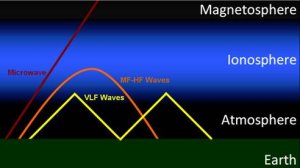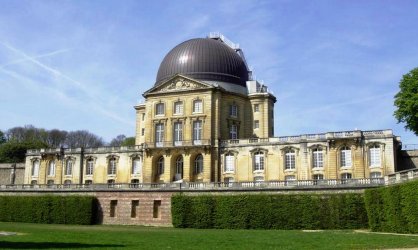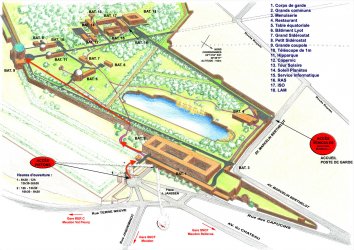International Workshop "Ionosphere at low frequency"
I - Scientific rational
The Earth atmosphere is described in several layers following the height evolution of the neutral density and temperature. From about 70km another layer appears composed of ionized particles : the ionosphere. This layer is of particular interest for its role in the global electrical currents of the Earth magnetosphere but also in long distance radio transmission (still used on disaster regions for example). The Earth and ionosphere serve then as waveguide to transmit the information.

- VLF waves transmission
A scheme of the propagation of different types of waves in the Earth-Ionosphere wave guide.
Quite surprisingly, the lowest parts of the ionosphere (70-100km) are almost unknown. Indeed, they are too low to be explored by spacecraft but too high for balloons sounding.Taking advantage of the reflection of the VLF-waves on the ionosphere, the time evolution of the electric conductivity (and thus the electron density) can be inferred on localized area of the ionosphere.
The variation of the electron density is particularly important during solar flares. Thus, electron density disturbances can propagate in the ionosphere, generating perturbations of waves transmission. This may be critical for some industrial activities (like radio broadcast or civil aviation).
Multiplying the receiver stations around Europe can enable to draw maps of the conductivity, in almost real time. The aim of the meeting is to gather people interested in participating to this network of low frequency receivers, for mid-latitude regions, in particular Europe.
II - Program
The meeting will take place at the Meudon site of the Paris observatory, on April 26 2018.
Program
- 09 :30 – 10 :00 « Ionosphere at low frequency » M. Clilverd
- 10 :00 – 10 :20 « Global Ionospheric and Thermospheric Effects of the June 2015 Geomagnetic Disturbances : Multi-Instrumental Observations and Modeling » E. Astafyeva
- 10:20 - 10:40 « Synchronized Pulsations in the Earths Lower Ionosphere and Solar Flare Emission » L. Hayes
- 10 :40 – 11 :00 « VLF propagation perturbations associated with single meteors » F. Colas
- 11 :00 – 11 :20 Coffee Break
- 11 :20 – 11 :35 « September 2017 solar flares as seen by the Meudon Observatory VLF-receiver » C. Briand
- 11 :35 – 11 :50 « The UAH VLF monitoring station » C. Cid
- 11 :50 – 12 :10 « "Potential use of Digisonde to detect Solar Flares » E. Blanch
- 12 :10 – 12 :30 « Ionospheric Research at INGV » L. Alfonsi
Lunch and visit of the VLF monitor
- 14 :00-14 :30 « The AARDDVARK network » M. Clilverd
- 14 :30 – 15 :00 « LATNET and SAVNET » J.P. Raulin
- 15 :30 – 16 :00 « GIFDS » N. Jakowski
- 16 :00 – 16 :20 – Coffee Break
- 16 :20 – 17 :00 Discussion
III - List of participant
- Lucilla Alfonsi, INGV, Italy
- Elvira Astafyeva, IPGP, France
- Daniela Banys, German Aerospace Center, Germany
- Estefania Blanch, Ebro Observatory, Spain
- Carine Briand, LESIA, Paris Observatory, France
- Consuelo Cid, Alcala University, Spain
- François Colas, IMCCE, France
- Nicole Cornilleau-Wherlin, LPP, France
- Mark Clilverd, British Antarctic Survey, UK
- Germain Dang Kièn, TelecomParisTech, France
- Florent Deleflie, IMCCE, France
- Maxime Dubard, LESIA, Paris Observatory, France
- Dominique Fontaine, LPP, France
- Alberto García Alcala University, Spain
- Antonio Guerrero, Alcala University, Spain
- Rajkumar Hajra, LPC2E, France
- Laura Hayes, Trinity College, Ireland
- Norbert Jakowski, German Aerospace Center, Germany
- Aurélie Marchaudon, IRAP, France
- Stephen Prust, Exeter Met Office, UK
- Jean-Pierre Raulin, Mackenzie Presbyterian Institute, Brazil
- Luc Sagnière, MacGhill University/IMCCE, Canada/France
and in remote :
- Francesca Zuccarello, Catania Observatory, Italy
- Ed Stone (and colleagues), Exeter Met Office, UK
- Researchers for Tor Vergata University, Italy
IV - Pratical information
The webpage of the LESIA gives information about lodging in Paris and venue to Meudon.
The meeting will take place in the old castle on the Meudon site.
To access the castle, enter by the main gate ("Acces Piétons"), if open clim the stairs and then follow the road (if the stairs are not opened, folllow the road since the main gate). When entering the castle is on your left ahnd.



